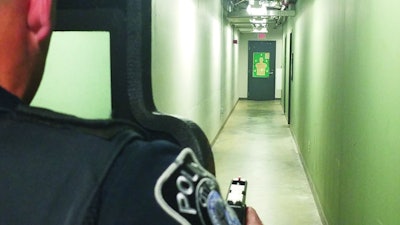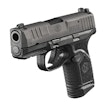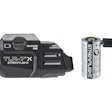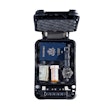![[|CREDIT|]](https://img.policemag.com/files/base/bobit/publicsafety/image/2019/06/pm.we_opener_brianmarshall_sz.jpg?auto=format%2Ccompress&fit=max&q=70&w=400)
The effectiveness and simplicity of using lasers as sighting tools is hard to deny. Most shooters using a laser for the first time quickly understand that putting a projected laser dot on target should result in a hit close to that point of aim if the trigger press doesn't move the gun significantly.
We have also seen the other practical benefits lasers have in use-of-force confrontations. Agitated or potentially violent subjects sometimes become compliant at the sight of laser that signifies the activation of an electronic control device (ECD). But as with many handgun accessories such as weapon-mounted lights or red-dot sights we may have pre-conceived ideas about the usefulness of laser sights before being properly trained in their use.
I became a fan of laser sighting when I took Marshall Schmidt's Laser Sight Instructor Course at the Annual Training Conference for the International Association of Law Enforcement Instructors in 2005. I went into that class with all the pre-conceived objections about why lasers wouldn't be useful. But I quickly learned that I could still detect which laser was mine in a swarm of other red beams when sighting the same target. I also saw that I could focus on the target itself and not my front sight and make accurate hits. Finally, I discovered that when using a laser sight I could hold my gun in unconventional positions and deliver accurate fire.
Laser Basics
I have now carried a variety of red laser systems on my duty pistols and rifles for several years, and I have noticed how suspects react differently when the laser sight is activated in confrontations. There is certainly a psychological deterrence effect when a person begins to think "if they shoot, they won't miss," even if that is true or not.
Training on reflexive activation of the laser is critical if it is going to be used on a defensive pistol. If a user is not going to be smooth, fast, and natural when it comes to turning it on, then don't mess with the laser, "unless you have enough time to talk." In a confrontation when deadly force is imminent, aim your gun by whatever method is fastest and most effective. As Marshall Schmidt put it, "use enough sight to take the shot," whether that is a flash front sight, the front sight focus, a point shot, the hot spot of a weapon light, or the laser. If the laser requires fumbling, then only use it when you have time to activate it during verbal commands.
Going Green
I've talked primarily about red lasers; now let's look at green. It's long been known that green lasers are better for daylight operations because they are more visible in sunlight. But they used to be comparatively expensive, so red was the only option for many officers. Now, green laser systems have become more affordable and are being used by more and more officers.
I can recall my first duty application of a green laser sight. Our SWAT team had stacked on a house where a suspect was barricaded. We had just deployed CS/CN gas into the home. When the suspect emerged, I was able to easily target him using the laser sight (instead of the iron sights on my AR-15) with the gas mask on and not break the seal on my mask.
![[|CREDIT|]](https://img.policemag.com/files/base/bobit/publicsafety/image/2019/06/pm.we_over-under-d_brianmarshall_sz.jpg?auto=format%2Ccompress&fit=max&q=70&w=400)
Over time I began to see more benefits of green laser sighting. When running a ballistic shield, operators often extend their forearms in front of the shield to get a view of the iron sights or red-dot sights on a handgun through a view port. With a laser sight, the pistol can be held closer to the shield and not require the same degree of exposure.
Using green lasers on firearms can help distinguish lethal weapon sighting from a less-lethal weapon or ECW sighting, which has traditionally used a red laser sighting system. For officers using red-dot equipped optics, the projected green laser will not confuse their point of aim when they look through their handgun or rifle RDS.
Non-Traditional Sighting
We have all heard at some point in our career that the key to improving marksmanship is front sight focus. In my experience, I shoot paper and steel much better when I can really focus on the front sight, making the rear sight fuzzy and the target a bit blurry. However, in force-on-force training or real-world shootings, we often hear the officer report that they are doing a "flash front sight" or what could be called "point shooting" as they focus on their threat and fire. It is frustrating as a firearms instructor to spend hours on a range trying to reinforce a fundamental sight picture, only to have it not translate over to real use-of-force applications.
In my testing, the use of a green laser greatly improved the shooters' awareness of where their rounds will strike while tracking a moving target or watching the hands of a role player who is trying to dig though pockets to produce a weapon, a wallet, a cellphone, or nothing at all.
![[|CREDIT|]](https://img.policemag.com/files/base/bobit/publicsafety/image/2019/06/pm.we_shield-c_brianmarshall_sz.jpg?auto=format%2Ccompress&fit=max&q=70&w=400)
I have found that when handling my firearm in non-traditional stances like climbing attic stairs or looking down the length of drain culvert pipes that I had greater ability to target using the laser to aim.
Sure, there are drawbacks. We understand that lasers point both ways. The laser projection can "give away" our position, but I can't think of too many situations I have encountered in 23 years where the police really snuck up on anyone or they didn't know we were there when guns became involved. Older green lasers could fail in temperatures outside their operating limits, but current models have a -40F to 120F range. We don't ever want to become dependent on an electronic device that could fail, break, or run out of batteries.
There are also policies that must be established if an agency allows its officers to use laser sights. We don't want to put lasers on center mass of non-threats or persons we have not yet identified as potential threats. So it becomes crucial to have a policy and to train officers correctly in the proper activation of the laser and where it can be pointed at different times in a confrontation. For proper tactical illuminator training methods, see "Tactical Illuminator Training," POLICE, March 2017 (https://www.policemag.com/342207/tactical-illuminator-training).
Like any handgun accessory, whether it is a pistol mounted light, red-dot sight, or laser, we cannot just slap it on a gun and assume we know how to use it correctly. All supplemental systems like these require properly vetted and researched training to understand their correct use and benefits.
In our studies, we cannot determine a "clear winner" of the red dot vs. laser vs. iron sight system. They all do some things well and have shortcomings. It's not much different than debating what is the best patrol car when comparing fractions of a second in 0-60 mph times or interior volume.
Usings Lasers and Optics
The Streamlight TLR-2HL Green, a combination LED weaponlight/green laser piggy back, has become my primary light laser on long guns. I installed the laser at the six o'clock position on my forend and zeroed the lasers at 50 yards. With my red-dot optic on top of the rifle also zeroed at 50 yards, the holdover on the top of the rifle (about 2 inches) is very close to the hold under of the green laser on the bottom.
 A laser sight allows this shield bearer to hold his handgun closer to the shield and have a full view through the shield's port.Photo: Brian Marshall
A laser sight allows this shield bearer to hold his handgun closer to the shield and have a full view through the shield's port.Photo: Brian Marshall
With both systems activated I can look through my optic and see the red dot and the green dot. At 50 yards they intersect. At any distance closer than 50 yards the round will strike halfway between the red and green dots. So at 7 yards on a hostage rescue target, the red dot holdover might be aimed in the high forehead of the terrorist, but the green laser beam would project around the mouth area, and result in an impact area at the bridge of the nose between the eyes.
Brian Marshall is a 23-year veteran of law enforcement, and a member of the International Association of Law Enforcement Firearms Instructors. He teaches for the Texas State University ALERRT programs and the Steyr Arms Academy.












